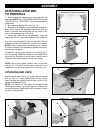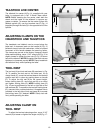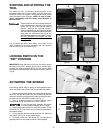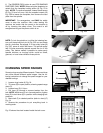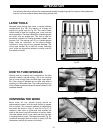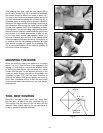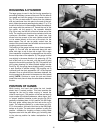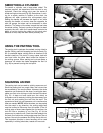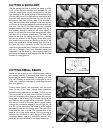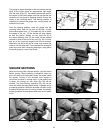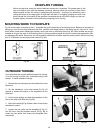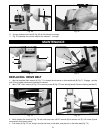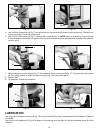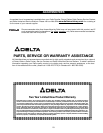
16
SMOOTHING A CYLINDER
To smooth a cylinder, use a large skew chisel. This
requires practice, but experience with this tool is very
important. Place the cutting point near the center of
chisel and high on the work (Fig. 38). Sometimes, in striv-
ing for a certain position in relation to the work, the
beginner will often overlook this all-important point.
Raising the handle will increase the depth of cut while
lowering the handle, of course, does the opposite. As
with the gouge, the skew can be advanced in either
direction. The center of the skew toward the heel does
the actual cutting. The back portion of the grind or bevel
supports the tool, while the handle-hand controls the
depth of cut by rocking the chisel on this pivot point.
Because of this, keep the skew bevel perfectly flat.
Fig. 38
Fig. 39
Fig. 40
USING THE PARTING TOOL
The parting tool is perhaps the easiest turning chisel to
handle. Simply push this scraping tool into the work Fig.
39. A somewhat better cutting action is obtained if the
handle is held low. This tool is, in many cases, held with
one hand while the other hand holds the calipers in
the cutting groove. When parting tool cuts are deep, a
clearance cut should be made alongside the first cut
(Fig. 40) to prevent burning the tool point.
SQUARING AN END
The parting tool can be used to quickly square an end.
Since the parting tool is a rough cutter, the cut can then
be smoothed by the use the skew. However, the whole
operation can be done with the skew. In using the skew,
make your first cut a nicking cut with the toe of the skew
(Fig. 41). A deep cut here could burn the chisel, so
a clearance cut is made by inclining the skew away from
the first cut and pushing the tool into the work. This
procedure of side cut and clearance cut is continued as
often as needed. NOTE: While the skew can be pushed
into the wood in any direction, the cutting edge itself
must be inclined a little away from this plane .If the full
cutting edge of skew bears against the cut surface, the
tool will have a tendency to run. See Fig. 42 for the
proper way to make the cut. Push the chisel straight into
the work, and incline the cutting edge away from the cut
surface. Use only the extreme end of the toe for this cut.
This important principle in skew handling will be used
repeatedly in making shoulders, beads and vee cuts.
Fig. 42
Fig. 41



